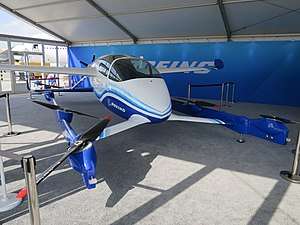Boeing Passenger Air Vehicle
The Boeing Passenger Air Vehicle (PAV) is an American autonomous personal air vehicle prototype developed by the Boeing NeXt division of Boeing with the assistance of Aurora Flight Sciences.[1]
| Passenger Air Vehicle | |
|---|---|
 | |
| Boeing Passenger Air Vehicle mockup at Dubai Air Show 2019 | |
| Role | Personal air vehicle |
| National origin | United States |
| Manufacturer | Boeing NeXt |
| First flight | 22 January 2019 |
| Introduction | planned for 2024 |
| Status | Under development |
Development
Boeing subsidiary Aurora Flight Sciences designed an electric VTOL prototype, developing it to prototype by 2019.[1] First, a model 1:10 was used to test the concept; it was flown with and without a fuselage. Further flight tests, with a 1:4 scale concept aircraft, were also conducted by Aurora.[2]
The PAV first flew on January 22, 2019, in Manassas, Virginia,[3] hovering before further tests and a transition to forward flight.
Design
The three-surface aircraft has twin booms each supporting four lift rotors slightly angled alternatively outward and inwards, a pusher propeller and the rear wing has vertical surfaces at each end.
Accident
On June 4, 2019, the PAV crashed during its 5th test flight. Boeing representatives declined to disclose details of the crash.[4]
During the flight test engineers noted some brief data dropouts and abnormal motor speeds, and decided to terminate the flight. The pilot entered the autoland command, and after a small descent, the aircraft motors went to idle and the aircraft impacted the runway. The aircraft was substantially damaged. A review of the recorded data revealed that vibration occurred and briefly exceeded the jerk logic threshold used to detect contacts to the ground (in addition to squat switches). The aircraft entered the ground mode, subsequently commanding the motors to shutdown.[5]
Specifications (PAV)
Data from Electric VTOL News and THE VERGE,[2][6] (January 2019)
General characteristics
- Crew: None (autopilot)
- Capacity: 2 passengers, 225 kg (496 lb) payload
- Length: 30 ft 0 in (9.14 m)
- Wingspan: 28 ft 0 in (8.53 m)
- Empty weight: 1,268 lb (575 kg)
- Max takeoff weight: 1,764 lb (800 kg)
- Powerplant: 1 × Horizontal Electric
- Powerplant: 8 × Vertical Electric each 100 hp (75 kW)
- Propellers: 5-bladed
Performance
- Cruise speed: 110 mph (180 km/h, 97 kn)
- Range: 50 mi (80 km, 43 nmi)
See also
- Air taxi
- Flying car (aircraft)
Related development
Aircraft of comparable role, configuration and era
Related lists
References
- "Boeing Autonomous Passenger Air Vehicle Completes First Flight" (Press release). Boeing. Jan 23, 2019.
- "Aurora Passenger Air Vehicle (PAV)". Electric VTOL News.
- "Boeing's autonomous electronic VTOL passenger vehicle completes first flight". intelligent-aerospace.com. 23 January 2019. Retrieved 23 March 2020.
- Siebenmark, Jerry (2019-06-12). "Boeing's Autonomous Prototype Crashes". Aviation International News.
- NTSB Preliminary Report
- Andrew J. Hawkins (23 January 2019). "Boeing's experimental autonomous aircraft completes its first test flight". theverge.com. Retrieved 23 March 2020.
External Links
- Andrew J. Hawkins (January 23, 2019). "Boeing's experimental autonomous aircraft completes its first test flight The latest 'flying car' test as the aviation industry moves toward urban aerial mobility". The Verge.
- Carrie Hampel (January 24, 2019). "Boeing VTOL takes test flight as flying taxi". electrive.